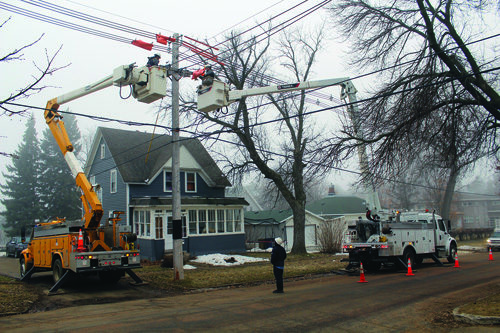Safe setup of aerial devices
What environmental factors should electric utility crews consider when setting up aerial devices on a worksite?

Responding is Jim Olson, senior product engineer, Terex Utilities Inc., Westport, CT.
Before starting the project, it’s a good idea to send right-of-way agents and surveyors to determine if special permits will be needed from the Department of Natural Resources or other wildlife organizations. It may also be necessary to use ground protection mats or create an access road to provide travel routes for aerial devices and other trucks. Lastly, installing barricades or fencing helps to protect the site before the crew arrives.
Upon arrival at the work location, conduct a site survey to identify potential hazards, evaluate ground conditions and consider the terrain. If installing new poles, call 811 before you dig to locate all underground utilities.
Potential hazards include buildings, ditches, drop-offs, holes, debris, sewers, overhead obstructions, electrical conductors, underground utilities and exposure to traffic. When considering the position of the aerial device, make sure no part of the bucket truck, including the boom and platform, can come in contact with trees, buildings or utility poles. Always establish and maintain proper minimum approach distance from energized power lines. The bucket truck cannot protect you from phase-to-phase or phase-to-ground contact, which means you need to allow for sag, sway or rocking as you position and operate the aerial device.
Traffic poses another hazard. Aerial devices often must share the road and roadside with the public. If traffic is an issue, the utility crew should use signalpersons to caution drivers. It’s important to be aware that if the elbow overhangs outside the body, it will intrude into traffic lanes. Don’t operate with the boom or platform over open traffic lanes.
In addition, always clear the area of bystanders and jobsite debris, including downed power lines and fallen tree limbs. Tree limbs can become energized when contacting a live power line. Other potential environmental hazards are the ambient conditions, including temperature. Operating in extreme weather conditions requires you to take extra precautions to protect your crew and truck.
Next, evaluate the ground conditions. The ground must be firm enough to support the pressure produced by the bucket truck, including the maximum platform and jib loads, during operation. Use pads under the outriggers to distribute the weight over a greater surface area. If your bucket truck doesn’t have outriggers, or is equipped with only one set, make sure all the tires and axle suspension springs are equally loaded. If the ground is slippery, covered in snow or icy, consider how to prevent the vehicle from sliding.
Third, consider the terrain. If the vehicle must be parked on a slope, chock the wheels and work off the rear of the truck. Per ANSI A92.2, bucket trucks are stability-tested on firm, flat surfaces up to a five-degree slope. Never work with the vehicle set up at an angle greater than what is allowed by the manufacturer. Use your bucket truck’s chassis level indicator to make sure the truck is always set within the manufacturer’s operational limits. Follow the instructions for your vehicle, and recognize that some trucks must be leveled before raising the booms.
If the task involves using the aerial device’s jib and the unit is set up on a slope greater than allowed, the unit can tip or roll over. This is especially true if you’re lifting from the side. If necessary, level the truck using cribbing. It’s possible to stack multiple outrigger pads to gain height as needed, or use an engineered stackable cribbing product. Always position the outrigger foot in the center of the outrigger pad.
An aerial device is a tool that – like all tools – must be used and maintained properly. Although it’s the responsibility of the employer to ensure each operator is properly trained and qualified to operate the aerial device following the instructions and precautions in the operator’s manual, it takes the whole crew to contribute to safe and efficient operations. Evaluation of environmental factors is a critical part of the process. If you determine during the site survey and setup that the jobsite isn’t safe, don’t operate in the area until you can make it safe for your crews, your equipment and the community.
Editor's note: This article represents the independent views of the author and should not be construed as a National Safety Council endorsement.
Post a comment to this article
Safety+Health welcomes comments that promote respectful dialogue. Please stay on topic. Comments that contain personal attacks, profanity or abusive language – or those aggressively promoting products or services – will be removed. We reserve the right to determine which comments violate our comment policy. (Anonymous comments are welcome; merely skip the “name” field in the comment box. An email address is required but will not be included with your comment.)

